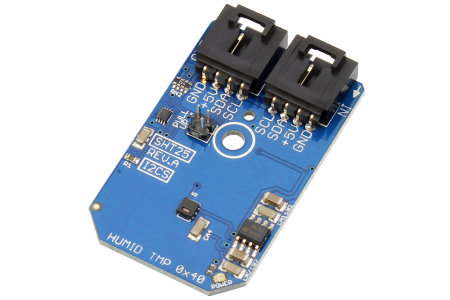SHT25 Humidity and Temperature Sensor
The SHT25 is a Humidity and Temperature Sensor.
This Device is available from ControlEverything.com [SKU: SHT25_I2CS]
https://www.controleverything.com/content/Humidity?sku=SHT25_I2CS
This Sample code can be used with Raspberry Pi, Arduino, Particle Photon, Beaglebone Black and Onion Omega.
Download and install pi4j library on Raspberry pi. Steps to install pi4j are provided at:
Download (or git pull) the code in pi.
Compile the java program.
$> pi4j SHT25.javaRun the java program.
$> pi4j SHT25Download and install smbus library on Raspberry pi. Steps to install smbus are provided at:
https://pypi.python.org/pypi/smbus-cffi/0.5.1
Download (or git pull) the code in pi. Run the program.
$> python SHT25.pyDownload and install Arduino Software (IDE) on your machine. Steps to install Arduino are provided at:
https://www.arduino.cc/en/Main/Software
Download (or git pull) the code and double click the file to run the program.
Compile and upload the code on Arduino IDE and see the output on Serial Monitor.
Login to your Photon and setup your device according to steps provided at
https://docs.particle.io/guide/getting-started/connect/photon/
Download (or git pull) the code. Go to online IDE and copy the code.
https://build.particle.io/build/
Verify and flash the code on your Photon. Code output is shown in logs at dashboard.
https://dashboard.particle.io/user/logs
Download (or git pull) the code in Beaglebone Black.
Compile the c program.
$>gcc SHT25.c -o SHT25Run the c program.
$>./SHT25Get Started and setting up the Onion Omega according to steps provided at :
https://wiki.onion.io/Get-Started
To install the Python module, run the following commands:
opkg updateopkg install python-light pyOnionI2CDownload (or git pull) the code in Onion Omega. Run the program.
$> python SHT25.pyInstall the Boards Manager on your Arduino IDE. The Steps are provided at:
http://www.arduinesp.com/getting-started
Download (or git pull) the code and double click the file to run the program.
Compile and upload the code on Arduino IDE and see the output on Serial Monitor.
Copy the IP Address of your ESP8266 from Serial Monitor and paste it in your Web Browser to see the result on Web Server.
Note: Your system and ESP8266 should be connected to same Wi-Fi Network.
#####The code output is the relative humidity in %RH and temperature reading in degree celsius and fahrenheit.
